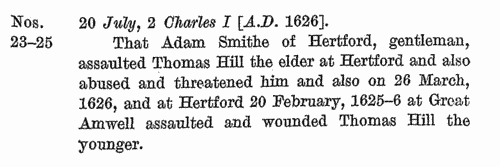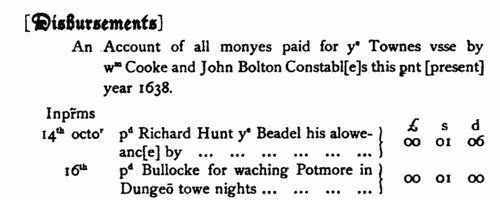Add this eBook to your basket to receive access to all 240 records. Our indexes include entries for the spelling moores. In the period you have requested, we have the following 240 records (displaying 11 to 20): These sample scans are from the original record. You will get scans of the full pages or articles where the surname you searched for has been found. Your web browser may prevent the sample windows from opening; in this case please change your browser settings to allow pop-up windows from this site. Lancashire and Cheshire Marriage Licences
(1639-1644)
Licences for intended marriages in Chester archdeaconry, which covered Cheshire and Lancashire south of the Ribble (by far the most populous part of that county) | Sample scan, click to enlarge

| Hertfordshire Sessions
(1619-1657)
Incidents from the Hertfordshire Sessions Books and Sessions Minute Books. These cover a wide range of criminal and civil business for the county. | Sample scan, click to enlarge

| Stockport Court Leet
(1661)
This Court Leet and Court Baron with View of Frankpledge for the barony of Stockport was held 7th May in the 13th year of king Charles II. The court record, in a mixture of Latin and English, lists the jury, and proceeds to give their findings on recent trespasses, largely petty matters such as breach of the assizes of bread, ale and meat (presented by the alefounders), and minor nuisances (presented by the burlymen and the scavengers). The amercements were assessed by the affeerers, whose names are also given. | Sample scan, click to enlarge

| Stockport Court Leet
(1662)
This Court Leet and Court Baron with View of Frankpledge for the barony of Stockport was held 10th April in the 14th year of king Charles II. The court record, in a mixture of Latin and English, lists the jury, and proceeds to give their findings on recent trespasses, largely petty matters such as breach of the assizes of bread, ale and meat, and minor nuisances. The amercements were assessed by the affeerers, whose names are also given. | Sample scan, click to enlarge

| Stockport Court Leet
(1662)
This Court Leet and Court Baron with View of Frankpledge for the barony of Stockport was held 2nd October in the 14th year of king Charles II. The court record, in a mixture of Latin and English, lists the jury, and proceeds to give their findings on recent trespasses, largely petty matters such as breach of the assizes of bread, ale and meat (presented by the alefounders and officers for flesh), and minor nuisances and infractions (presented by the scavengers, constables, burlymen and moor lookers). In addition there are notes as to the transfer of burgages; orders warning individuals to cease transgressions and pains set for non-compliance. The amercements were assessed by the affeerers, whose names are also given. All the officers for the coming year were chosen (pp. 32-34) - assessors, apprizers, market lookers, alefounders, burlymen, searchers and sealers of leather, scavengers, moor lookers, mayor, bailiff, constables, and affeerers. | Sample scan, click to enlarge

| Inhabitants of Manchester, and travellers
(1633-1666)
The constables' accounts of the manor of Manchester in Lancashire from 1633 to 1647 were edited by J. P. Earwaker and published in 1892. The accounts largely consist of details of disbursements by the constables, and as such include payments to paupers and soldiers with passes to help them on their journeys to and from other parts of the country. Earwaker added nine 'important appendices' to the work: 1. Disbursements and Receipts during the Plague of Manchester, 1605-6 and 1606 (from State Papers Domestic in the Public Record Office); 2. List of the Books of Assessment, Charity Money Accounts, &c., now in the Possession of the Corporation; 3. List of the Inhabitants of Manchester in 1648 (pages 181 to 201); 4. List of the Inhabitants of Manchester in 1651 (202-221); 5. Disbursements of the Constables in 1651-2; 6. List of the Inhabitants of Manchester assessed in 1659 (225-246); 7. A Second List of the Inhabitants of Manchester in 1659 (247-260); 8. List of the Inhabitants of Manchester assessed in 1666 (261-283); and 9. List of Uncommon, Obsolete, and Dialect Words to be found in the Preceding Pages. | Sample scan, click to enlarge

| Lancashire and Cheshire Marriage Licences
(1661-1667)
Licences for intended marriages in Chester archdeaconry, which covered Cheshire and Lancashire south of the Ribble (by far the most populous part of that county) | Sample scan, click to enlarge

| Allegations for marriages in southern England
(1660-1669)
The province or archbishopric of Canterbury covered all England and Wales except for the northern counties in the four dioceses of the archbishopric of York (York, Durham, Chester and Carlisle). Marriage licences were generally issued by the local dioceses, but above them was the jurisdiction of the archbishop, exercised through his vicar-general. Where the prospective bride and groom were from different dioceses it would be expected that they obtain a licence from the archbishop; in practice, the archbishop residing at Lambeth, and the actual offices of the province being in London, which was itself split into myriad ecclesiastical jurisdictions, and spilled into adjoining dioceses, this facility was particularly resorted to by couples from London and the home counties, although there are quite a few entries referring to parties from further afield. The abstracts of the allegations given here usually state name, address (street in London, or parish), age, and condition of bride and groom; and sometimes the name, address and occupation of the friend or relative filing the allegation. Where parental consent was necessary, a mother's or father's name may be given. The ages shown should be treated with caution; ages above 21 tended to be reduced, doubtless for cosmetic reasons; ages under 21 tended to be increased, particularly to avoid requiring parental consent; a simple statement 'aged 21' may merely mean 'of full age' and indicate any age from 21 upwards. These are merely allegations to obtain licences; although nearly all will have resulted in the issuing of the licence, many licences did not then result in marriage. | Sample scan, click to enlarge

| Lancashire and Cheshire Marriage Licences
(1667-1680)
Licences for intended marriages in Chester archdeaconry, which covered Cheshire and Lancashire south of the Ribble (by far the most populous part of that county) | Sample scan, click to enlarge

| Treasury and Customs Records
(1685-1688)
Government accounts, with details of income and expenditure in Britain, America and the colonies
| Sample scan, click to enlarge

|
Research your ancestry, family history, genealogy and one-name study by direct access to original records and archives indexed by surname.
|











